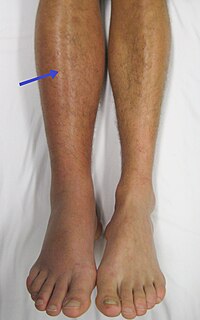
Photo from wikipedia
Background: D-dimer, a marker of ongoing procoagulant activity, has been widely used for the diagnosis of venous thromboembolism (VTE). The prognostic significance of D-dimer in stratifying VTE risk for acutely… Click to show full abstract
Background: D-dimer, a marker of ongoing procoagulant activity, has been widely used for the diagnosis of venous thromboembolism (VTE). The prognostic significance of D-dimer in stratifying VTE risk for acutely ill medical patients has not been well-established. Methods: A literature search was performed to collect studies that compared the incidence of short-term VTE between acutely ill medical patients with elevated or nonelevated D-dimer levels. The cutoff of D-dimer was 0.5 μg/mL or otherwise defined by included studies. The study endpoint was any occurrence of VTE (inclusive of deep vein thrombosis [DVT], pulmonary embolism, or VTE-related death) within 90 days of hospital presentation. A meta-analytic approach was employed to estimate the odds ratio (OR) with 95% CI by fitting random-effects models using the generic inverse variance weighted approach. Results: A total of 10 studies representing 31,119 acutely ill medical patients were included. Compared to those with nonelevated D-dimer levels, patients with elevated D-dimer had approximately threefold greater odds for short-term VTE within 90 days (OR, 3.28; 95% CI, 2.44 to 4.40; p < 0.0001). The association of elevated D-dimer with VTE composite (OR, 3.33; 95% CI, 2.20 to 5.02) and with DVT (OR, 3.26; 95% CI, 2.32 to 4.58) was comparable. The association was significant among patients who presented various acute medical illness (OR, 2.68; 95% CI, 2.01 to 3.58) and those who presented with acute stroke (OR, 3.25; 95% CI, 2.31 to 4.58). Conclusion: Elevation of D-dimer was predictive of the occurrence of VTE within 90 days among acutely ill medical patients.
Journal Title: Vascular Medicine
Year Published: 2022
Link to full text (if available)
Share on Social Media: Sign Up to like & get
recommendations!